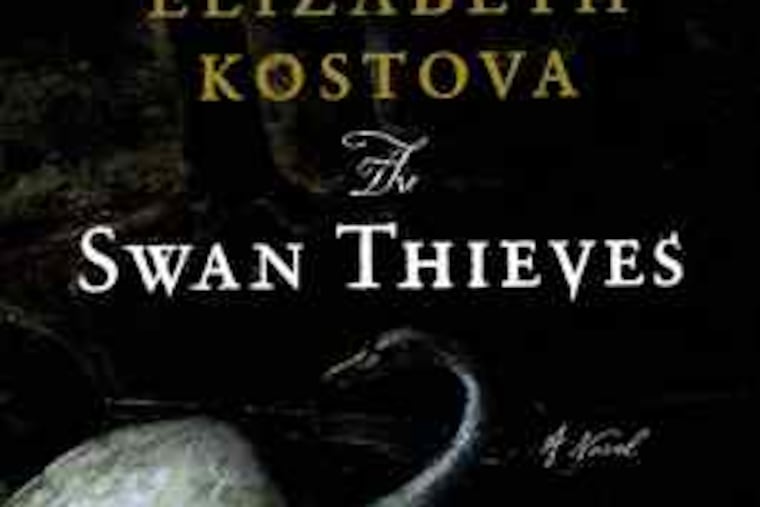Leda and the swan rigmarole
After hundreds of pages, you eventually do learn why a painter wielded a pen knife in a gallery.

By Elizabeth Kostova
Little, Brown. 564 pp. $26.99
nolead ends nolead begins
Reviewed by Frank Wilson
The best thing by far about Elizabeth Kostova's second novel is its basic story. Less fortunate is the manner of its telling.
First, the story: Robert Oliver, a painter of great talent and growing renown, has been confined to a mental hospital in Washington after a guard at the National Gallery stopped him from defacing a painting with a pen knife. The hospital is called Goldengrove and the psychiatrist's name is Andrew Marlow. Since his arrest, Oliver has stopped talking.
But he opens up briefly for Marlow, telling him that he did what he did for "her," who turns out to be "the woman I love." That, however, is neither his ex-wife Kate nor his ex-girlfriend Mary. Later we will learn, when Kate confronts her husband over a letter she has found in his pocket that she assumes is addressed to Mary, that the object of Robert's affection is dead.
The painting Oliver was in front of when he pulled out his knife is called Leda and is by a 19th-century French painter called Gilbert Thomas. Hanging beside it is Thomas' self-portrait.
Oliver clams up again after telling Marlow he can talk to anybody he likes, including Kate and Mary. Later, though, he gives Marlow a packet of letters written in French. These turn out to be a correspondence between two contemporaries of Gilbert Thomas, a woman named Béatrice de Clerval and her husband's uncle, Olivier Vignot. Both are painters, and Vignot exhibits regularly at the annual Paris Salon. Gilbert Thomas is mentioned from time to time, never flatteringly, in their correspondence.
Oh, I almost forgot: Marlow, who is a painter himself, provides Oliver with a full array of painting supplies, which he uses to paint and draw over and over again the same beautiful woman. Whether the image is from memory or imagination, no one but Oliver can say, and he's not talking.
Obviously, given a set-up like this, what the reader wants to find out is the reason Oliver attacked the painting in the National Gallery, the identity of the woman he keeps painting and drawing, and what any of this has to do with Olivier Vignot and Béatrice de Clerval. Rest assured, the reader does find all this out eventually.
But eventually is the operative word - which brings us to the manner of this tale's telling.
Andrew Marlow is the overall narrator. But there are chapters attributed to Kate (these, presumably, have been put together by Marlow from notes he has taken from his visit to her). Then there are chapters attributed to Mary (accounts written by her and sent to Marlow). Finally, there are selections from the letters between Olivier and Béatrice, and occasional chapters relating to their relationship.
Nothing ostensibly wrong with any of that, except that so little of it has to do with solving the mystery at the heart of the novel. Instead, it tells us more than we care, or need, to know about Marlow and his love life, Kate and her courtship and marriage, and Mary and her romance. We do learn a lot about Robert Oliver's physical presence: "I went to him and put my arms around him and caressed his head," Kate tells us, "the heavy curls, the massive forehead, feeling that surprising mind inside, the vast gifts I had always admired and wondered about." (We wonder about them, too, Kate.) And, just in case you weren't paying attention the first time, there's this: "When Robert came home from teaching, I touched his brown sweater and his curling, separating locks of hair, his stubbly chin, his back pockets, his calloused hands. . . . If I wasn't exhausted from the day, he touched me to keep me awake a little longer, and then I reached for his smooth, hairless flanks and . . . " - you get the idea.
Mary fills us in further with similar details. But none of it advances the story.
There is another odd feature. Gilbert Thomas, Béatrice de Clerval, and Olivier Vignot are all fictitious. But the book opens with two pages describing a real painting that hangs in the Musée d'Orsay. The book ends with us discovering that the woman in the painting had a connection to - the fictitious Béatrice de Clerval.
At one point, Mary writes to Marlow, "I think Robert was - is - a writer at heart, too; if someone had collected in order all those bits and pieces of his writing to me, they would have made a kind of short and impressionistic but very good novel about his daily life and the nature he was constantly trying to paint."
It certainly would have made a better novel than The Swan Thieves.